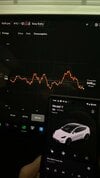I recently picked up my 2023 model y LR and have driven it less than 400 miles (600km) but noticed it has really horrible mileage.
Two Instances:
The energy consumption menu states pretty normal ranges at 216 miles at 78% making it 277 miles (446km) at full charge. According to the other screens I am also using a lot of energy at lifetime 318Wh/mile (198wh/km).
Setup:
I drive like a grandpa and have my profile set on "chill" plus I did not do any highway driving so all my miles are within 45 miles/h (70km/h). It also has not been very cold at around 44.6°F (7°C) ambient temperature and I like to set my cabin temperature at 70°F (21°C) with the driver seat heater at level 1. I also always start my ride at 85% battery since that is my charge limit. With all these factors I feel like the consumption is still insanely high.
Does anyone else have poor mileage: Does this warrant concerns? Should I take my Tesla in to examine given the novelty of the car and the fact that I want to point out any factory defects early on?


Two Instances:
- I would go 10 miles (16km) in city driving and it would eat up 6% battery making the mileage 166 miles (270km) on full charge.
- In another instance I drove it 40 miles (65km) and it used up 20%, making the mileage 200 miles (355km) on full charge.
The energy consumption menu states pretty normal ranges at 216 miles at 78% making it 277 miles (446km) at full charge. According to the other screens I am also using a lot of energy at lifetime 318Wh/mile (198wh/km).
Setup:
- 2023 Model Y Long Range Dual Motor AWD
- 20" induction wheels
- 5 seater
- Lithium Ion Battery (Not LFP)
- British Columbia, Canada
I drive like a grandpa and have my profile set on "chill" plus I did not do any highway driving so all my miles are within 45 miles/h (70km/h). It also has not been very cold at around 44.6°F (7°C) ambient temperature and I like to set my cabin temperature at 70°F (21°C) with the driver seat heater at level 1. I also always start my ride at 85% battery since that is my charge limit. With all these factors I feel like the consumption is still insanely high.
Does anyone else have poor mileage: Does this warrant concerns? Should I take my Tesla in to examine given the novelty of the car and the fact that I want to point out any factory defects early on?




